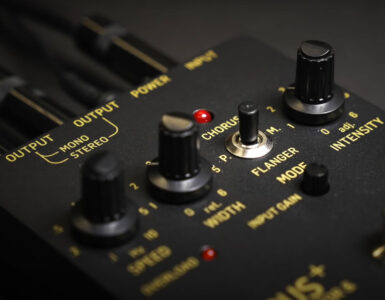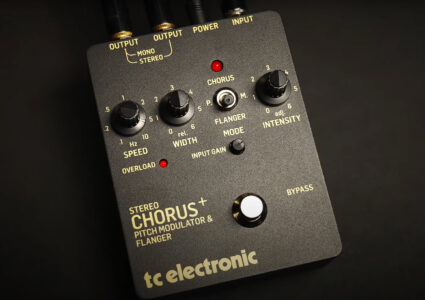Hailing from a stompbox pedal that is truly TC Electronic royalty, the all-new Stereo Chorus Flanger Gold (SCF Gold) is instantaneously born into legendary status. This is because its predecessor – the original SCF – was TC Electronic’s debut pedal, produced in 1976.
In fact, it was TC Electronic’s first ever product. And what better way to celebrate their 45th company anniversary than with a new and improved version of the stompbox that started it all.
Produced for a staggering 40 straight years, the original SCF displayed a serious amount of longevity. Now, it’s considered one of the best modulation pedals of all time.
It’s celebrated for the highly controllable sound of its bucket brigade circuit, alongside a wonderfully diverse chorus which is perfect for guitar, bass, vocals, and keyboards. One of the most renowned features of the original SCF, though, was its noise-cancelling ability.
If you’re into your guitar pedals, you’ll know that many analogue choruses tend to screech and produce a lot of unwanted noise, especially at high outputs. The original SCF was so good at squashing this irritating quirk that it was nicknamed ‘The Sound of Silence’ by its adoring faithful.
So, how does the SCF GOLD stack up against its predecessor? I’ve had a go, to find out just that. It’s a lot to live up to, but true to their form of the last four decades, TC Electronic have smashed it out of the park – without trying too hard.
First impressions
 As soon as I plugged into the SCF GOLD, I was taken aback by the tonal enhancement it brought to the table. A balanced mixture of brightness and warmth provides a lively yet controlled feel to your guitar. It begs you to start playing as hard as you can.
As soon as I plugged into the SCF GOLD, I was taken aback by the tonal enhancement it brought to the table. A balanced mixture of brightness and warmth provides a lively yet controlled feel to your guitar. It begs you to start playing as hard as you can.
I also found that no matter what kind of playing style or sound I opted for, the pedal took to it like a duck to water. Be it extended open chords, muted picking, or aggressive riffing, the SCF GOLD felt right at home, showing off its diversity like a kid with new shoes.
It’s easy to find your way around too – and aside from the gold text, the control layout is identical to that of the original SCF. There are three control knobs for Speed, Width, and Intensity. A 3-way toggle switch then allows you to select either the Chorus, Pitch Modulation, or Flanger effects. Just below the toggle selector is the Input Gain control, and at the bottom is the bypass footswitch.
One particularly impressive tonal feature of the SCF GOLD is its clarity. As far as you push this pedal, its definition is retained. It’s wonderfully focused, and from what I have read/researched, this seems to be a noticeable feature that distinguishes it from its predecessor.
Subtle but effective
As previously mentioned, the original SCF was designed in 1976. To be in circulation for 40 years before any update is a statement in itself. Walking the line of innovation must be difficult when you have already landed on such a successful recipe. This is perhaps why the changes made for the SCF GOLD are relatively minimal.
There have been four main changes to the SCF GOLD – the first of which is the analogue preamp. This has been revised to deliver a warmer tonal voice and additional headroom. I found that it’s especially noticeable in the lower frequencies and contributes further to the magnificent tonal palette that this pedal boasts across the scale.
The other three updates improve the general functionality and include a noticeably larger power/LFO LED light alongside mono and stereo outputs.
In addition, a switch from the original PSU power input to a standard 9V input brings the pedal into the 21st century.
Chorus
 The first effect mode boasted by the SCF GOLD is the Chorus.
The first effect mode boasted by the SCF GOLD is the Chorus.
Easily manipulated through highly intuitive controls, the speed knob manages the delay span rate. It ranges from a more intensive film reel style – with 10 cycles per second – to a somewhat smoother and lazier 10 seconds per cycle. Of course, you can sit anywhere in between.
I found that the speed control had a much subtler effect on an already-understated chorus sound. Not that that’s a bad thing though – the chorus resides delicately underneath the natural tone of the guitar. It complements any additional effects that you have in your rig – especially delays and overdrives.
The pedal’s brightness is continuously prominent when you’re accessing the chorus mode. A lot of chorus effects pedals – such as the Boss CH-1 or Electro-Harmonix’s Electric Mistress – can produce a much darker, murkier sound. This gives the SCF GOLD its own unique flavour.
The width control manipulates the delay time that is left in between the repeating waveforms. But it’s the intensity control that is this pedal’s true party piece.
When in chorus mode, the intensity acts as a wet/dry blend. So, when you turn it up, you get a seriously bright and modulative chorus effect that’s full of life.
Across the board, and particularly when in the chorus mode, the SCF GOLD retains its clarity and brightness thanks to the bucket brigade circuit design. It’s what the original SCF was famed for – and the result is a natural chorus voice that will adapt to whatever style you run it through.
Pitch modulation
Pitch modulation can be a vast and untamed wilderness that’s difficult to wrap your head (and hands) around at times. This pedal keeps it very simple.
With the speed and width knobs manipulating the sound in the same manner as the chorus, the intensity control is where you’re likely to find your ideal pitch modulation sound. The intensity knob offers a tailorable balance between the vibrato and chorus effect – so you can edit with a fine-tooth comb to make this pedal your own.
Likely the most delicate of the bunch, the pitch modulation setting is another subtle but lethal weapon, and it responds extremely well to being pushed hard.
Perhaps because of its understated nature, I found that when you’re running the guitar through an overdriven setting, playing in octaves, or just wanting a little bit of extra oomph… the pitch modulation was perfect. It brought greater width and power to the mix.
This is where the input gain comes into play. At first glance, it may not seem as important as the other controls, but the input gain helps regulate and balance the dynamics between the main three controls. This provides an extra level of volume and thickness to the body of the tone.
Turning the input gain high when in the pitch modulation setting helps build the modulations and adds a gritty punch to the sound, ranging from more full-bodied output to lighter modulative harmonics.
Overall, the input gain is extremely useful for controlling the balance of all your settings, as well as dictating the general aggression of SCF GOLD’s sound. Although turning it up high can mean sacrificing some of the pedal’s clarity, with a bit of patience and a lot of tweaking, you can definitely find a sweet spot that allows you to get the best of both worlds.
Flanger
 The flanger has the more extreme effect settings of the three. If you’re looking for the opportunity to get a little bit weird with the SCF GOLD, this is where you can do it.
The flanger has the more extreme effect settings of the three. If you’re looking for the opportunity to get a little bit weird with the SCF GOLD, this is where you can do it.
From wobbling wubs in the lows to swirling soundscapes in the highs, the flanger effect lets you get really creative with all the control options. And it reacts differently depending on how you manipulate the speed, width, and intensity.
When in this effect mode, the intensity knob effectively acts as a feedback control. You can mix and match the strength of this effect control with the input gain to regulate the flanger sound. This places it right on the edge of overpowering for a more extreme sonic experience.
It was when I pushed the flanger to its limits that I realised the true power of this pedal’s output and how it can warp the tone of your guitar to sound like some sort of metallic being come to life. You can get more vocal sounds out of the flanger effect when you turn it up high, truly expanding your creativity.
Personally, I prefer some of the more subtle effects when it comes to modulation pedals. If you’re the same, the best response I found from the flanger effect was at a high-speed rate with low intensity and low/mid input gain. This created some gorgeous, tremolo-like, pulsating modulations which pair beautifully with extended resonant chords.
Final thoughts
Highly intuitive, modulative, and pulsating to the brim with tailorable effects – the SCF GOLD is another great offering from TC Electronic.
They’ve stayed true to the original SCF and not attempted to update anything that didn’t need to be altered. They have, however, brought the pedal into the 21st century whilst paying homage to their 45 years of pedal history.
Best described as push and pull, the SCF GOLD can flow whichever way you desire. It’s the perfect tool for pushing your performance that bit further on stage. If you’re in need of extra depth and power, the SCF GOLD can deliver in spades, and it will also allow your creative side to flourish.
If not for its diverse range of effects, then certainly for its naturally bright, clear, and deliciously rich tones, I would say the SCF GOLD could also be great for studio use.
I tried running the pedal through speakers and an interface into a DAW. Thankfully, it retains all its best features when used through a recording system. Not only will it translate an otherworldly guitar sound to your tracks, but it could also be easily paired with keyboards or synths and even be used with vocal effects.
Personally, I would highly recommend the SCF GOLD. Put simply, it’s the updated version of one of the greatest and most long-standing guitar pedals ever made. What more could you ask for?





0 Comments